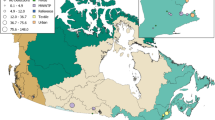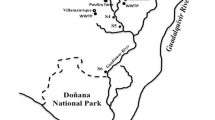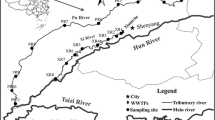Abstract
Objectives
To examine nonylphenol (NP) and 4-t-octylphenol (OP) concentrations and general water quality indicators along a river in the greater Tokyo area and to specify the distribution and origin of alkylphenols.
Methods
Water was sampled from the Edogawa River, a main river in the greater Tokyo area, which is a source of public drinking water; and the Sakagawa River system, a tributary of the Edogawa River. To determine alkylphenol in river water. NP and OP concentrations were quantified using gas chromatography-mass spectrometry (GC-MS).
Results
The detection rates of NP above the detection limit were 100% in both rivers, and those of OP were 75.0% in the Edogawa River and 92.9% in the Sakagawa River system. The median NP and OP concentrations in the Edogawa River were 0.24 μg/1 and 0.066 μg/l, and those in the Sakagawa River system were 0.87 μg/l and 0.19 μg/l respectively. Alkylphenol concentrations are significantly higher in the Sakagawa River system than in the Edogawa River. In the Sakagawa River system, the NP and OP concentrations were highest in the water along the nonindustrial area with an underdeveloped sewerage system.
Conclusions
NP and OP were detected widely in the Edogawa River and Sakagawa River system. Endocrine-disrupting chemical (EDC) pollution in a river by the inflow of urban wastewater was demonstrated. A systematic monitoring of alkylphenols in tributary rivers and streams as well as in main rivers will help control EDC pollution and protect the source of drinking water in urban areas.
Similar content being viewed by others
References
Colborn T, Dumanoski D, Myers JP. Our Stolen Future. New York: Dutton; 1996.
Renner R. European bans on surfactant trigger transatlantic debate. Environ Sci Technol. 1997;31:316a-320a.
Japan Environment Agency. Strategic Programs on Environmental Endocrine Disrupters ’98 (SPEED ’98). November 2000 Edition ed. Tokyo: Environmental Health and Safety Division, Environmental Health Department. Japan Environment Agency; 2000.
Nayor CG, Mieure JP, Adams JW, Weeks JA, Castaldi FJ, Ogle LD, et al. Alkylphenol ethoxylates in the environment. J Am Oil Chem Soc. 1992;69:695–703.
Blackburn MA, Waldock MJ. Concentrations of alkylphenols in rivers and estuaries in England and Wales. Water Res. 1995;29:1623–1629.
Ahel M, Giger W, Schaffner C. Behaviour of alkylphenol polyethoxylate surfactants in the aquatic environment—II. Occurrence and transformation in rivers. Water Res. 1994; 28:1143–1152.
Bennie DT, Sullivan CA, Lee HB, Peart TE, Maguire RJ. Occurrence of alkylphenols and alkylphenol mono-and diethoxylates in natural waters of Laurentian Great Lakes basin and the upper St. Lawrence River. Sci Total Environ. 1997;193:263–275.
Japan Environment Agency. Survey of Endocrine Disrupting Chemicals (Environmental Hormones) in the Aquatic Environment (FY 1999). Tokyo:Water Quality Management Division, Water Quality Conservation Bureau, Japan Environment Agency; 2000.
Horiguchi T, Shiraishi H, Shimizu M, Yamazaki S, Morita M. Imposex in Japanese gastropods(neogastropoda and mesogastropoda): Effects of tributyltin and triphenyltin from antifouling paints. Mar Pollut Bull. 1995;31:402–405.
Guillette LJ Jr, Gross TS, Masson GR, Matter JM, Percival HF, Woodward AR. Developmental abnormalities of the gonad and abnormal sex hormone concentrations in juvenile alligators from contaminated and control lakes in Florida. Environ Health Perspect. 1994;102:680–688.
Jobling S, Sumpter JP. Detergent components in sewage effluent are weakly oestrogenic to fish: Anin vitro study using rainbow trout(Oncorhynchus mykiss) hepatocytes. Aquat Toxicol. 1993;27:361–372.
Jobling S, Sheahan D, Osborne JA, Matthiessen P, Sumpter JP. Inhibition of testicular growth in rainbow trout(Oncorhynchus mykiss) exposed to estrogenic alkylphenolic chemicals. Environ Toxicol Chem. 1996;15:194–202.
Soto AM, Sonnenschein C, Chung KL, Fernandez MF, Olea N, Serrano FO. The E-SCREEN assay as a tool to identify estrogens: an update on estrogenic environmental pollutants. Environ Health Perspect. 1995;103:113–122.
Gronen S, Denslow N, Manning S, Barnes S, Barnes D, Brouwer M. Serum vitellogenin levels and reproductive impairment of male Japanese Medaka(Oryzias latipes) exposed to 4-tert-octylphenol. Environ Health Perspect. 1999;107:385–390.
Talmage SS. Environmental and Human Safety of Major Surfactants: Alcohol Ethoxylates and Alkylphenol Ethoxylates. Boca Raton: Lewis Publishers; 1994.
Japan Environment Agency. Quality of the Environment in Japan 1999 (white paper on environment: 1999 edition). Tokyo: Japan Environment Agency; 2002.
Edogawa River Work Office. Our Edogawa River. Noda: Edogawa River Work Office, Kanto Regional Development Bureau, Ministry of Land, Infrastructure and Transport; 2001. (Article in Japanese).
Clear Stream Renaissance II Edogawa River and Sakagawa River area council. Urgent Action Plan for Improvement of the Water Environment in the Sakagawa River and Midstream of Edogawa River among Tonegawa River System: Clear Stream Renaissance II. Noda: Clear Stream Renaissance II, Edo river and Saka river area council: 2003. (Article in Japanese).
Japan Environment Agency. Endocrine Disrupting Chemicals Interim Investigation Manual (Water, Sediment, and Aquatic Organisms). Tokyo: Water Quality Management Division, Water Quality Conservation Bureau, Japan Environment Agency; 1998. (Article in Japanese)
Japanese Industrial Standards Committee. Testing Methods for Industrial Wastewater: (Japanese Industrial Standards-K0102). Tokyo: Japanese Industrial Standards Committee; 1998.
Environment Canada. Canadian Environmental Quality Guidelines for Nonylphenol and Its Ethoxylates (Water, Sediment, and Soil). Scientific Supporting Document. Ecosystem Health: Science-based Solutions Report. No. 1-3. Ottawa: National Guidelines and Standards Office, Environmental Quality Branch, Environment Canada; 2002.
European Commission European Union Risk Assessment Report: 4-nonylphenol (branched) and Nonylphenol, Volume 10 (EUR 20387 EN) Luxembourg: Office for Official Publications of the Europiean Communities; 2002.
Footitt A, Virani S, Corden C, Graham S. Nonylphenol Risk Reduction Strategy, Final Report, for the Department of the Environment, Transport and the Regions. London. Risk & Policy Analysis Limited; 1999.
Ministry of the Environment. Report on the Test Results of Endocrine Disrupting Effects of Nonylphenol on Fish (Draft). Tokyo: Environment Health Department, Ministry of the Environment, Government of Japan; 2001.
Ministry of the Environment. Report on the Test Results of Endocrine Disrupting Effects of Nonylphenol on Ecosystem Using fish (Draft). Tokyo: Environment Health Department, Ministry of the Environment, Government of Japan; 2002. (Article in Japanese).
Bureau of Waterworks Tokyo Metropolitan Government. Result of endocrine disrupting chemicals surveillance in tap water and its source water in 1999 fiscal year. In: Water Quality Yearbook in Fiscal Year 1999. Tokyo: Bureau of Qaterworks Tokyo Metropolitan Government; 2000. p. 139–145. (Article in Japanese)
Edogawa River Office. Kogasaki River Purification Plant. Noda: Edogawa River Office, Kanto Regional Development Bureau, Ministry of Land, Infrastructure and Transport 2006.
Johnson AC, White C, Bestien TJ, Jürgens MD. The sorption potential of octylphenol, a xenobiotic oestrogen, to suspended and bed-sediments collected from industrial and rural reaches of three English rivers. Sci. Total Environ. 1998;210/211:271–282.
Ying GG, Williams B, Kookana R. Environmental fate of alkylphenols and alkylphenol ethoxylates—a review. Environ Int. 2002;28:215–226.
Matsudo City. Present Situation and Countermeasure on the Environment in Matsudo City (2000 fiscal year version). Matudo. Matsudo City; 2000. (Article in Japanese)
Isobe T, Satoh A, Ogura N, Takada H. Determination of nonylphenol by GC-MS in environmentla samples in Tokyo. Journal of Japan Society on Water Environment. 1999;22: 118–126. (Article in Japanese)
Isobe T, Nishiyama H, Nakashima A, Takada H. Distribution and behavior of nonylphenol, octylphenol, and nonylphenol monoethoxylate in Tokyo Metropolitan area: their association with aquatic particles and sedimentary distributions. Environ Sci Technol. 2001;35:1041–1049.
National Institute of Technology and Evaluation. Risk Management Report—Current Status and Management Goals—Nonylphenol and Nonylphenol Ethoxylates. Tokyo: Chemical Management Center National Institute of Technology and Evaluation; 2004. (Article in Japanese)
Ministry of the Environment. FY 2004 Edition of Chemical Substance Fact Sheets. Tokyo: Environmental Health and Safety Division, Environmental Health Department, Ministry of the Environment, Government of Japan; 2005. (Article in Japanese)
World Health Organization. Guidelines for Drinking-water Quality. 3rd ed. Volume 1 Recommendations. Geneva, Switzerland, 2004.
Thomas KV, Hurst MR, Matthiessen P, Sheahan D, Williams RJ. Toxicity characterisation of organic contaminants in stormwaters from an agricultural headweater stream in south east England. Water Res. 2001;35:2411–2416.
Ministry of the Environment. Annual Report on the Environment in Japan 2005. Tokyo: Environmental Strategy Division, Environmental Policy Bureau. Ministry of the Environment, Government of Japan; 2006.
Author information
Authors and Affiliations
Corresponding author
Rights and permissions
About this article
Cite this article
Watanabe, M., Takano, T., Nakamura, K. et al. Water quality and concentration of alkylphenols in rivers used as source of drinking water and flowing through urban areas. Environ Health Prev Med 12, 17–24 (2007). https://doi.org/10.1007/BF02898188
Received:
Accepted:
Issue Date:
DOI: https://doi.org/10.1007/BF02898188




